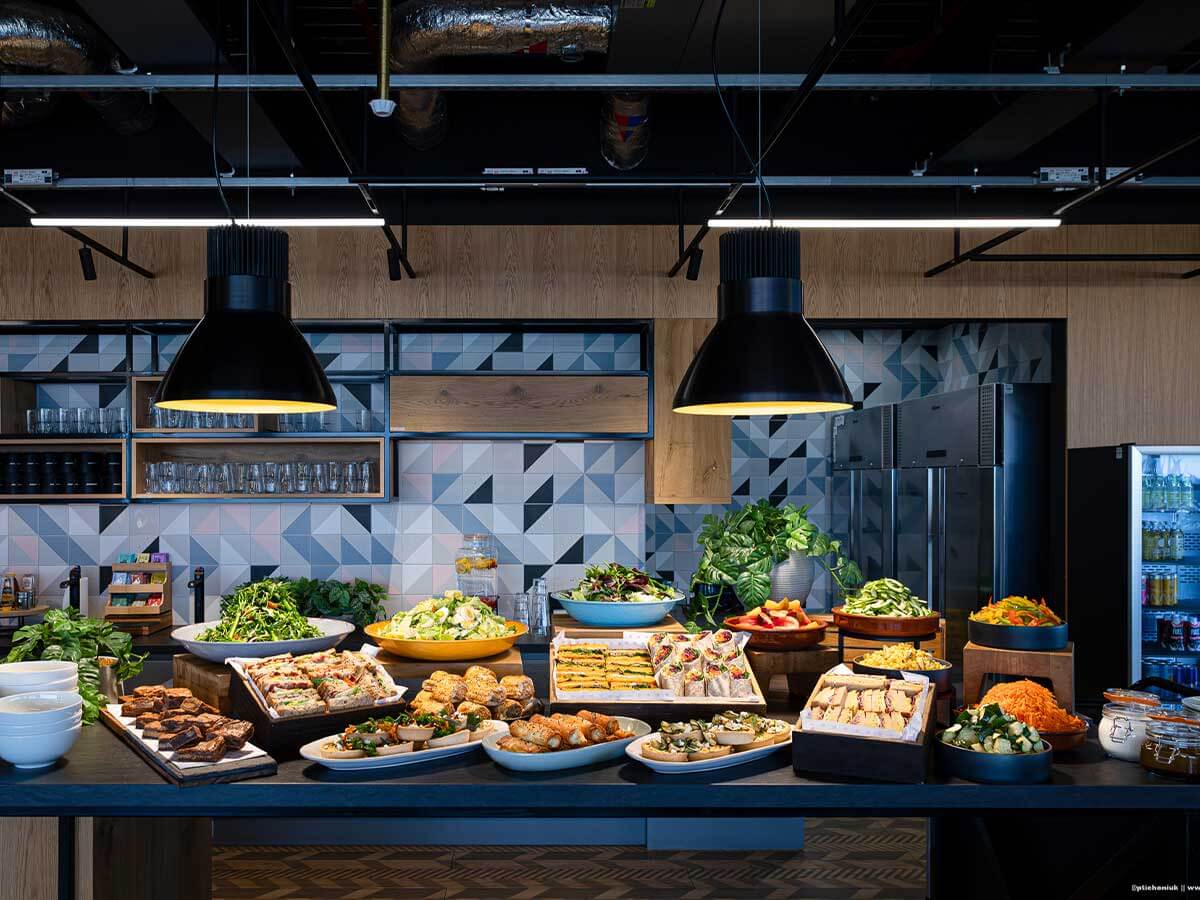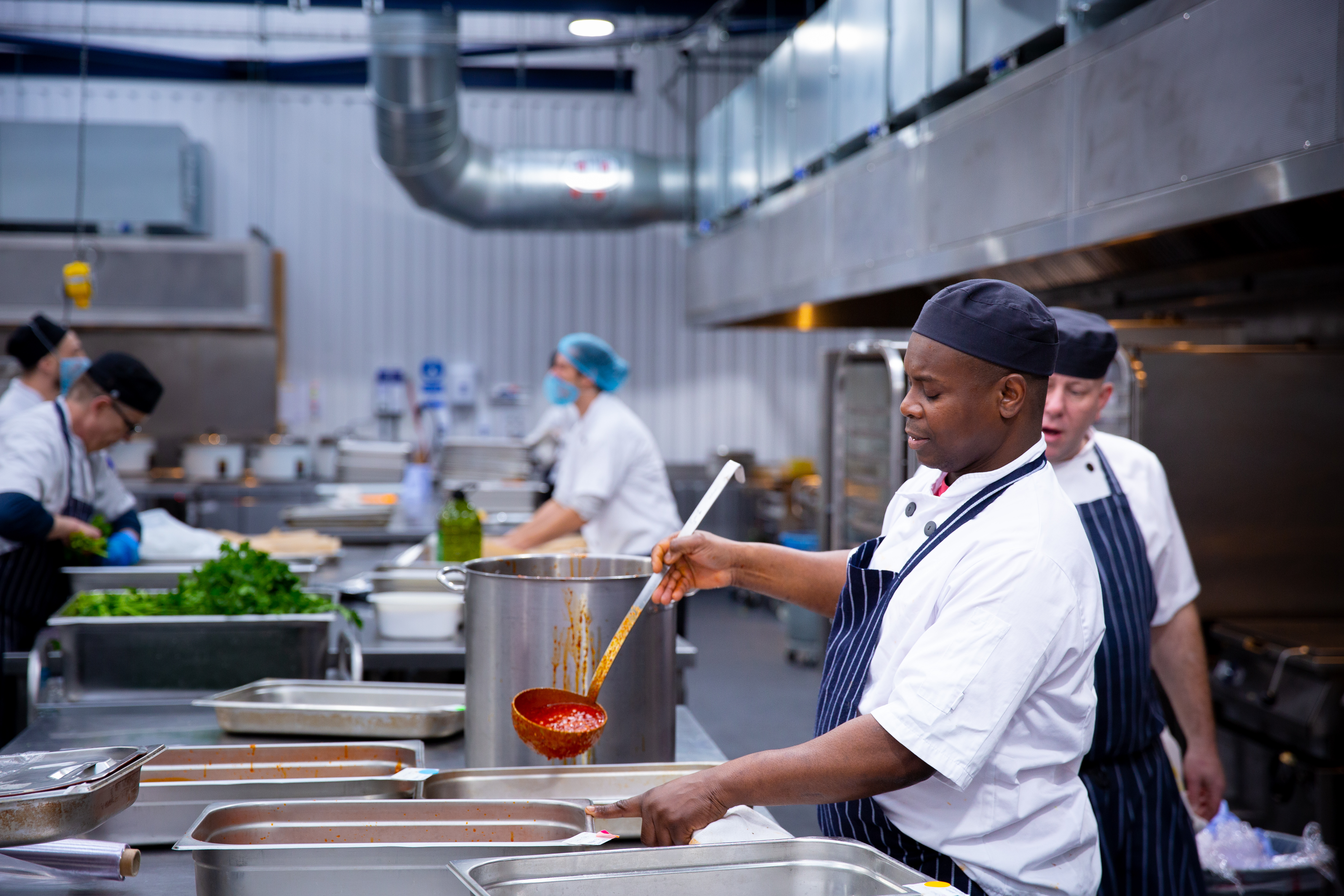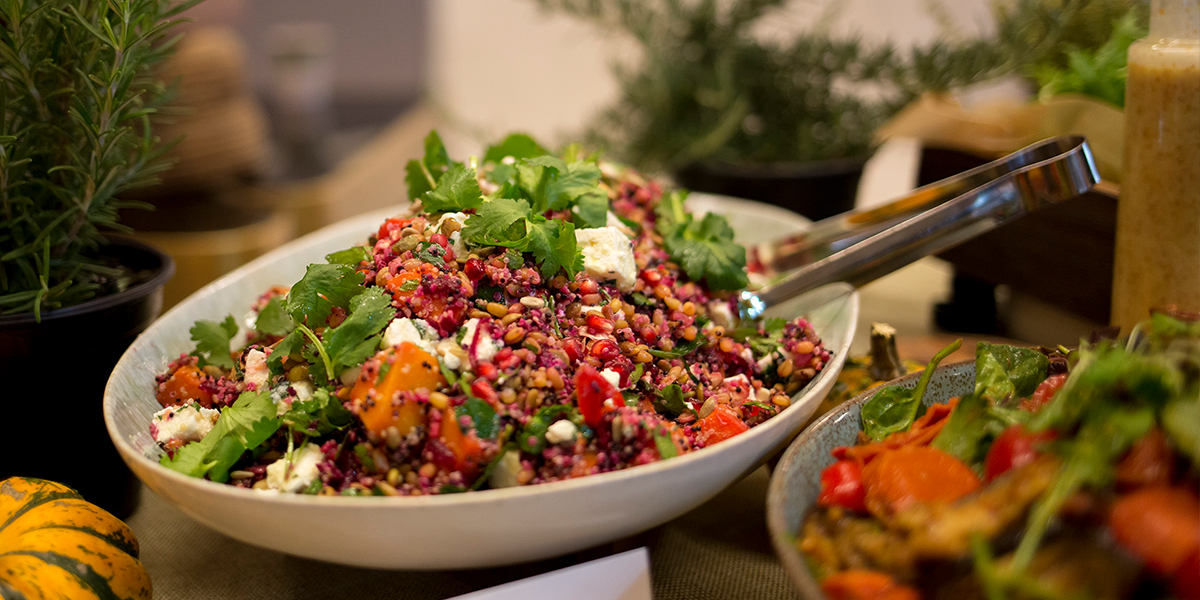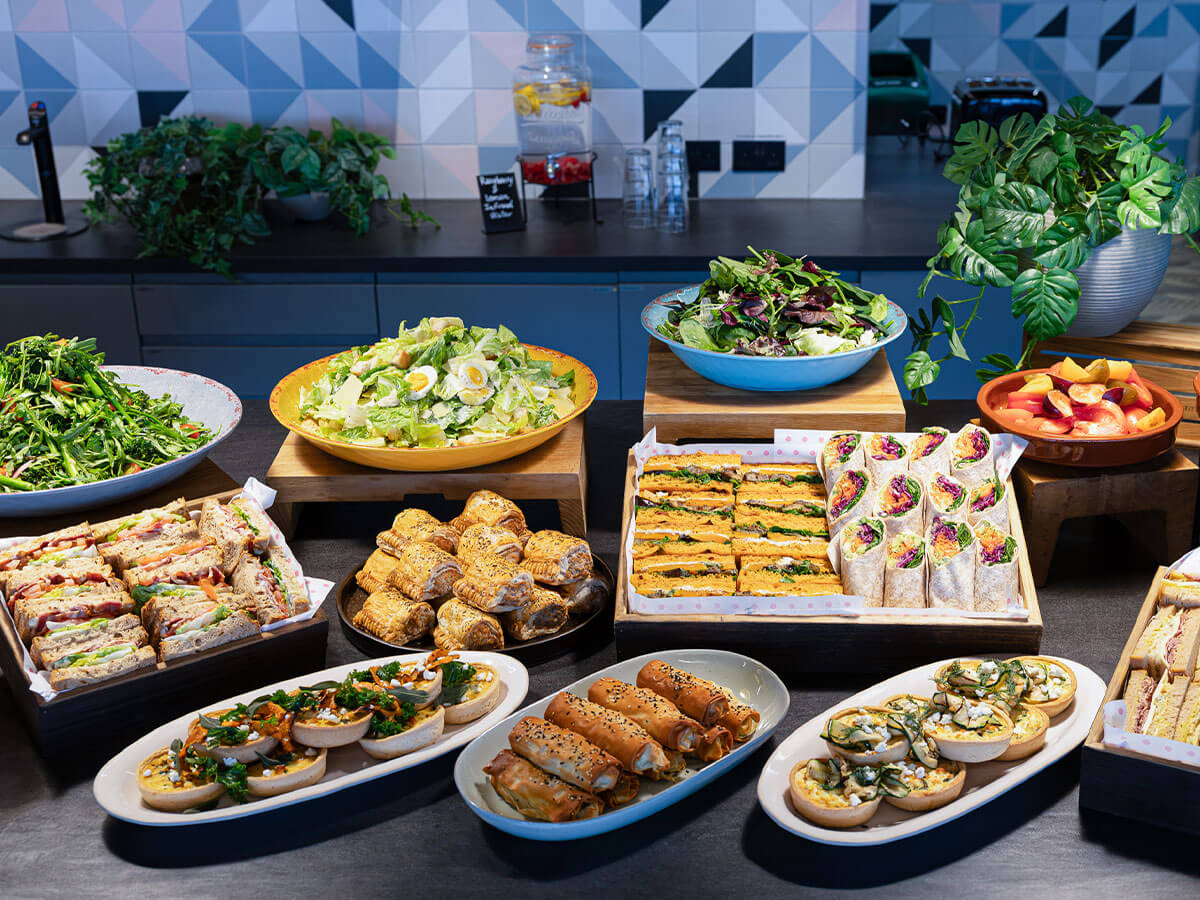Feeding an office might not be the first thing that springs to mind when you think about sustainability but it deserves more attention than it gets. Every meal, drink, and snack has an environmental footprint. From how ingredients are grown and transported, to how meals are packaged and delivered, the way we feed our teams matters.
No catering operation is ever going to be carbon-neutral with zero negative impact. But you can make more informed and responsible decisions that significantly improves your company’s effect on the planet and its communities. This year, why not put your catering on the sustainability agenda?
Sustainability in catering is easy to overlook. But think about it – you might be working hard to reduce emissions with smart temperature and lighting controls in the office, only to bring in dozens of lunches with single-use packaging every day. Meaning…there can easily be a disconnect between broader company policies.
The meals employees eat at work are a highly visible and simple way to show you care about the planet - and they can also help you meet your sustainability goals. Overly-packed meals turning up on swarms of mopeds says something very different from carefully considered, low-waste buffets made from seasonal ingredients.
The sustainability challenges of feeding offices in 2025
No office catering model is perfect when it comes to sustainability - and that includes a centralised model. While it can offer efficiency and oversight, this approach also requires a commitment to continuous improvement and honest reflection on environmental impact. As the old adage goes, “transparency is key!”
One of the key advantages of a centralised kitchen is the improved ability to monitor, assess, and implement sustainability strategies consistently. When food is prepared under one roof, rather than fragmented across multiple small kitchens, it’s easier to maintain high standards, track performance, and make meaningful changes.
While economies of scale play a role (fewer journeys, more efficient prep), the real benefit is the control and oversight it allows across sourcing, packaging, and waste management.
However, these benefits only materialise if your caterer adopts sustainability at its core. If you are currently assessing your catering partner, or even your own operations, you should think about the following:
Packaging waste:
App-based deliveries often involve layers of single-use packaging. Even compostable or recyclable options frequently don’t make it through the waste system properly.
But packaging waste doesn’t start and end in the canteen. What’s often overlooked is how ingredients arrive at the kitchen in the first place. Are they coming in reusable crates or single-use plastic wrap?
A genuinely sustainable approach looks at packaging across the entire journey, from supplier to prep to plate, and leans into reusables and bulk solutions wherever possible. If you’re exploring sustainable corporate catering that balances high‑quality food with strong environmental values, Fooditude integrates these practices into every meal.
Supply chain opacity:
Many businesses simply don’t know where their food is coming from when using multiple suppliers.The key isn’t just reducing the number of suppliers, it's about how those supplier relationships are managed. A strong partnership between the caterer and supplier allows for active collaboration, mutual accountability, and shared progress.
Caterers that assess their suppliers and support them in improving sustainability practices help build transparency throughout the supply chain, making it easier to trace sourcing, track emissions, and make informed improvements together.
Here at Fooditude, we track ingredients and emissions as part of our Scope 3 reporting and maintain long-term relationships with suppliers who share our sustainability goals.
We don’t get it right all the time, but being clear and honest helps us do better each day and we are constantly striving to reduce our environmental impact as a caterer.

Sustainable catering priorities in 2025
Ultimately, as you look to align your business operations with climate goals, your workplace catering can’t be left behind. The priorities for sustainable food programmes are becoming sharper, shaped by global need, employee expectations, and a growing awareness (and concern) of our planet’s resources and how we consume.
Here are some way you can take positive steps towards more sustainable food practices:
Menu transparency:
Carbon labelling is trending as a useful tool to help employees understand the impact of their meal choices. It’s not about finger-pointing, it’s about helping people make informed choices when it comes to how they eat and where their food comes from.
Thoughtful sourcing:
Choosing seasonally-focused produce is a proven way to reduce food miles. When so-called “other” ingredients are used, ask for clear sourcing information and what ethical standards your caterer is abiding by.
Reducing reliance on high-protein meat:
There's no need to go fully plant-based, but being more selective about which proteins are used can make a real difference.
Beef, lamb, and prawns carry some of the highest greenhouse gas emissions per gram of protein, while chicken and fish generally have a lower impact.
Making more climate-conscious menu choices, such as using red meat more sparingly or combining it creatively with other ingredients, can help reduce your catering footprint without compromising on flavour or variety.

Source: Our World in Data
Packaging overhauls:
Sustainability shouldn’t stop at the kitchen door. From how ingredients arrive at the prep site to how meals are served, the focus should be on minimising single-use plastics and embracing circular systems.
Supplier collaboration:
You can only be as sustainable as your supply chains allow. Strong partnerships with suppliers, especially those that share emissions data and are open to improvement—create the foundation for long-term impact.
Sustainability mistakes to watch out for
Even the most well-meaning initiatives can fall short if the strategy isn’t grounded in reality. Here are a few common sustainability traps you should aim to avoid:
1. Mistaking marketing for action
Some caterers make big sustainability claims based on minimal changes. A compostable box doesn’t mean much if it ends up in general waste. And a “local” label means little without a definition. Real sustainability demands more than clever wording, it requires data, targets, and accountability.
A good rule of thumb? Ask for the numbers. Whether it’s waste reduction stats, supplier audits, or a Net Zero roadmap (take a look at ours here), you’re entitled to more information about your caterer’s approach to sustainability.
2. Letting convenience take precedence
Meal delivery apps are convenient. But that convenience is resource-intensive e.g. multiple journeys, inconsistent sourcing, and a mountain of packaging waste. While these apps have their place, you want to create an office catering system that makes the right choice the easy one.
A food programme that is well rounded can offer variety and ease – especially if they’re set up with flexibility in mind. Pre-ordering systems, rotating menus, and allergy-sensitive meal planning can go a long way in balancing convenience with sustainability.
3. Skipping the employee conversation
Top-down sustainability changes rarely stick without buy-in from your team. If employees don’t understand the reasoning behind new policies or caterers - or worse, feel restricted - they’ll push back, quietly or otherwise.
A very valid fear around change, especially in catering, is that people worry they’ll lose choice or flexibility. That’s where diverse, rotating menus come in, offering variety without sacrificing sustainability goals.
But it is about more than just that, it's about bringing your team along on the sustainable eating journey. Communication and engagement are essential in building consensus with your teams. When the process is transparent and inclusive, change feels less like a mandate and more like a shared purpose.
The workplace canteen also has potential as a learning space, where people can see sustainability in action and discover new ways to eat with the environment in mind, without compromising on taste or quality.
Our own experience has shown that sustainability and satisfaction aren’t mutually exclusive. When both are given equal attention, that is where the magic happens.

How centralised catering helps you hit your sustainability goals
A centralised approach to catering can offer a clearer route toward measurable sustainability outcomes but only if the model is backed by data, deliberate choices, and a genuine commitment to reduce environmental impact through conscious decision-making.
One kitchen, one plan
Managing all food prep from a single site enables more control across the entire process such as ingredient sourcing, storage, packaging, delivery and food service set-up and take-down. When everything is coordinated under one roof, it’s easier to set sustainability targets, and to actually meet them.
Smarter delivery
Bulk deliveries can significantly reduce the number of catering trips made to offices compared to individual meal orders. It's more than just saving on fuel, it can help curb emissions and ease congestion in busy cities like London.
A practical step some caterers (like us) are taking is to gradually transition to electric delivery vans (EVs). However, rather than discarding petrol vehicles before their time, we’re keeping them on the road until the end of their service life. It’s a more sensible approach that avoids unnecessary waste and makes the shift to EVs more financially and environmentally efficient.
Less packaging, better systems
Delivered-in catering allows for reuse and bulk packaging of meals, taking away the need for single-use plastics for each member of staff. The difference this makes is huge, particularly when multiplied across hundreds of employees each day, especially when you offer more than one meal a day.
Food waste, in the bag
Tracking what’s being eaten (and what’s not) is much more straightforward when your catering partner uses a centralised approach and has a clear waste strategy, both in the kitchen and out of it (think ops). Data informs meal quantities and planning, helping reduce overproduction and waste.
Our Food Waste Project is a company-wide effort to stop edible food from ending up in the bin. We track the weight and types of food we waste across our operations using PowerBI dashboards, turning the data into something useful. It helps us better predict what clients actually want and helps them avoid over-ordering.
We have found that with some of the companies we work with, this approach has already led to massive reductions in food waste e.g. up to 47% in just six months, in one case.
Redistribution of surplus food
Prepared meals that go uneaten shouldn’t end up in the bin. With a reliable system and by working with local partners, surplus food can be safely redistributed to community-focused organisations. Through OLIO for example, one of our partners here at Fooditude, thousands of meals have been shared rather than wasted, supporting food accessibility to communities that need them, all while lowering excess.

How to move your catering sustainability strategy forward
Changing how you approach sustainability within your office catering is more than just switching suppliers, it’s about making sustainability the heart of your office food programme and incorporating it into every part of your management team’s decision-making process.
Here’s how to start:
Step 1: Assess where you are now
Run a catering audit. This is how you’ll identify your biggest sustainability risks when it comes to food at the office:
- How many deliveries are made per week?
- What sustainability measures are in place around delivery? Are fresh meals transported in fewer trips using vehicles with greater storage capacity?
- What materials are used for packaging, and how much ends up in general waste?
- How much food is wasted weekly - and what is the process for waste?
Does your current caterer provide visibility into their sourcing, emissions or waste strategy? - Having a baseline makes improvement measurable, not just theoretical.
Step 2: Define what “good” looks like
Once you’ve figured out where you stand, it’s time to map out where you want to go. Think beyond just tasty lunches…what do you want your workplace catering to look like in terms of sustainability?
Set realistic goals that make sense for your team and your values. These could include:
- Including catering in your overall sustainability strategy. Here’s ours!
- Setting a Net Zero target.
- Using more local, seasonal produce to cut down on food miles.
- Cutting food waste by a set percentage over the next year.
- Switching to reusable or compostable packaging.
- Adding carbon labels to help people understand the footprint of their food.
- Making sure all good food surplus goes to people who need it, not the bin.
You might be wondering what Net Zero means, so we have put together a brief description:
Net Zero means cutting greenhouse gas emissions as much as possible, then balancing out whatever’s left by removing the same amount from the atmosphere. In catering, this means getting emissions down across everything from how you cook, to how your ingredients are farmed, to how your food gets to the office.
At Fooditude, we have a roadmap to reach Net Zero by 2040. It’s a mix of big-picture changes (like moving to an electric fleet) and small, everyday ones (like how we plan our menus and work with suppliers). We’re learning as we go, and we share what works along the way.
Step 3: Choose a partner, not just a provider
Work with a caterer who sees sustainability as part of their everyday operations - not just a marketing trend.
Look for those who:
- Share real data, not just slogans and buzz words
- Involve their suppliers in emissions tracking and audits
- Experiment with ways to reduce impact, from the kitchen all the way to waste reduction
- Engage openly about challenges, not just wins
It’s also worth digging a little deeper into sustainability accreditations. Some sound impressive but require surprisingly little in the way of action or transparency. A shiny badge isn’t a substitute for meaningful effort, so always ask for use cases and examples.
Our works with partners like The Ferm give our vegetable off-cuts a second chance. Instead of throwing out things like cauliflower leaves or beetroot stems, we send them off to be turned into small-batch, vegan kimchi.
Want to see what our catering sustainability policy looks like? Check it out here.
Step 4: Bring your people with you for the ride
Change needs communication and buy-in. If employees don’t understand what’s happening or why, it’s unlikely to stick. Keep messaging simple, positive, and inclusive. Highlight your goals and wins - both environmentally and culinary. Make it easy for people to give feedback; and make sure that meals remain something everyone looks forward to.
Make smarter catering choices this year
Food is both culture and community. And in the workplace, it’s a daily expression of company values. Choosing a sustainable catering approach is a journey and a commitment. The good news is, you don’t need to do it alone.
At Fooditude, we’re still working towards perfect. But we are open, passionate, and deeply invested in doing things better. So if you’re ready to turn your office catering into a force for good, let’s have a chat.




